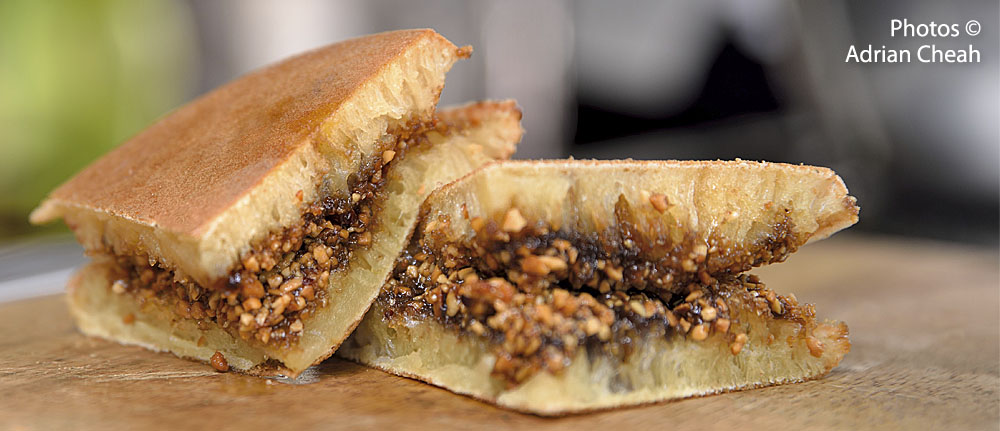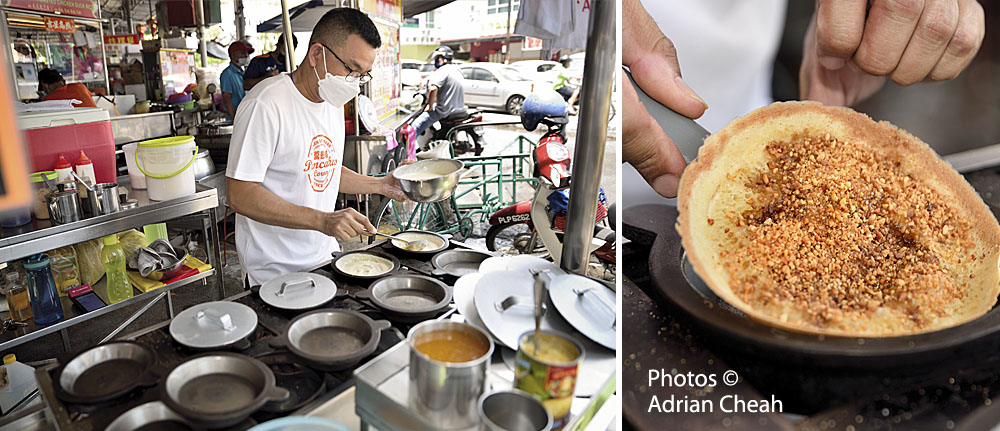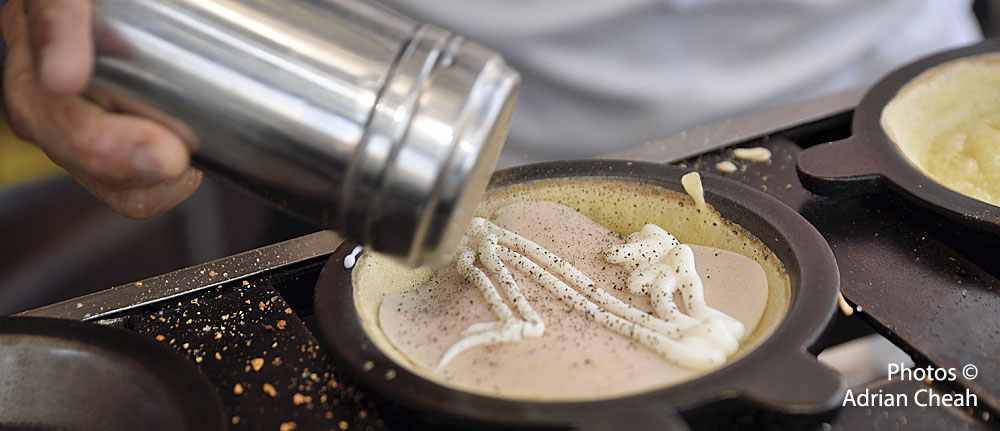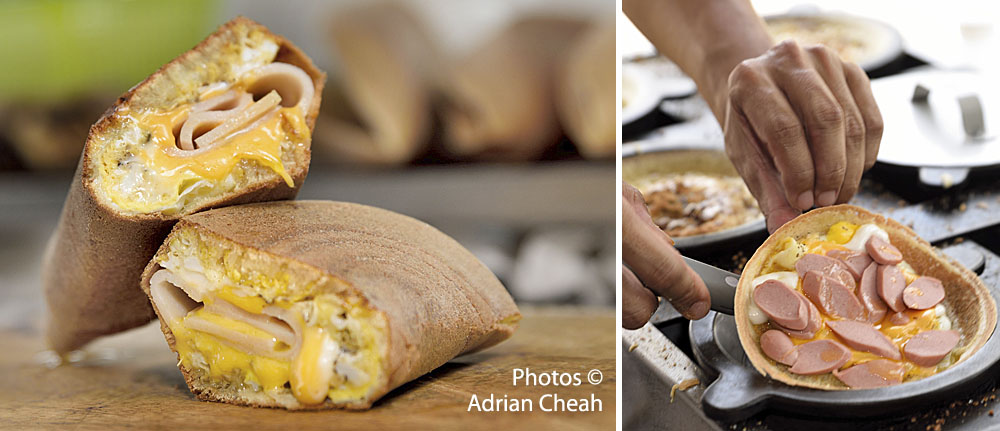Penang ban chien kuih, filled with grounded peanuts, creamed corn and more

Ban chien kuih, a popular street snack in Penang is easily available throughout the state. In Hokkien, ban chien kuih 慢煎粿 (or ban cien koay, ban chean kueh, ban chang kuih or ban jian kway) literally means "slow-fried cake".

This Chinese pancake is made by spreading a layer of batter into a 4.5-inch circular griddle pan before sprinkling over some sugar. A lid is then placed over to allow the pancake to cook though. When it is ready in a minute or so, a generous amount of toasted grounded peanuts is added along with some canned cream-style corn if desired. The final touch is a drizzle of melted margarine before the pancake is folded in halves then sold.

In Penang, there is also another thicker version of ban chien kuih that is cooked in a bigger cast-iron griddle that uses more batter. It is sweetened with either brown or white sugar and topped with grounded peanuts. The freshly cooked pancake is then cut into halves, folded over and further then cut into smaller triangle and rectangle pieces. This ban chien kuih has a springy honeycomb texture and a soft chewy bite. I buy this from a stall located at the corner of Jalan Pasar and Solok Moulmein at the Pulau Tikus market. The husband-and-wife duo, Mr and Mrs Neoh Kooi Aun, operate in the mornings from about 8:00 am onwards. Mr Neoh is the third generation selling ban chien kuih, continuing his grandfather's legacy who migrated to Penang from China.
Let us now take a close look at the 4.5-inch semicircle delight. For this version, a popular stall I frequent is conveniently accessible – only a short distance from my office. This uncle-nephew team mans a push-cart stall in front of Joo Huat Restaurant in Perak Road.
Mr Goh Gim Peng's father started a ban chien kuih stall in Anson Road in 1958. He offered both types of pancakes mentioned above and through the years, garnered a string of loyal customers. In 1988, Gim Peng took over the business and continued to serve hundreds of traditional ban chang kuih daily. Being a bachelor, Gim Peng wanted to pass on his knowledge to the next generation. Lucky, his nephew Chyau Uei was willing and they established Pancake Corner.


In 2005, Chyau Uei left his profession as an established hair stylist and never looked back. When his late grandfather caught wind of this, he thought his grandson was crazy, knowing very well that manning a ban chien kuih stall was back-breaking work. Chyau Uei, however, looked at the entire business quite differently. He saw great potential to extend the business further. With the support of his uncle, Gim Peng, they entered into a partnership to serve more that grounded peanuts, creamed corn and egg toppings. They extended the topping list to include bananas, peanut butter, blueberry jam, raisins, chocolate sauce, grated coconut, tuna, ham, cheese, pork floss and sausages. Prices vary according to the selection of fillings.




I believe that being innovative and having the drive to persevere lead to the passage of success. Here, the classic ban chien kuih has been elevated to new heights. Some combinations of flavours are brilliant – chocolate and banana; egg, ham and cheese with a dusting of black pepper; peanut butter and grounded peanuts; grated coconut with brown sugar; as well as blueberry jam with raisins. Like Pancake Corner, there are many ban chien kuih stalls in Penang today that have shifted gears to offer a wider selection to their discerning customers.


I have eaten too many below par ban chien kuih that are simply unforgivable. Oftentimes, the batter is all wrong, thus sad pancakes are produced. Some pancake makers are so stingy with the batter that the outcome tastes more like a biscuit. The main ingredients in the batter include flour, sugar, eggs and bicarbonate soda. For that nice chewy, honeycomb texture, some gluten needs to form in the batter. Allowing the batter to rest is equally important, at least 1–2 hours. Gim Peng starts preparing the batter at 11:00 am to get ready for business at 1:00 pm. Using his father's recipe, the batter has to be mixed once again with more ingredients prior to cooking. Do you know that the weather, on a sunny or rainy day, has a direct influence on the rise of the batter? Only someone like Gim Peng with decades of experience will be able to fine-tune the batter to perfection.
The internet has countless videos teaching us how to make ban chien kuih. Some add rice flour and yeast while others use baking powder; everyone thinks they have the winning formula. Ban chien kuih is something I will refrain from making at home. It is so much more rewarding to drop by Pancake Corner for a scrumptious treat.

When I was growing up in the 1970s, ban chien kuih made a hearty breakfast when an egg was added to it. I would wait patiently for the egg pancake to cook as it would take a little more time, maybe about an additional five minutes or so. When ready, the ban chien kuih maker would line the pancake with a sheet of newsprint before putting it into a plastic bag. For maximum satisfaction, I would savour the delicious offering as soon as possible when the edges still crispy. Left to cool, the vapour from the piping hot pancake in the plastic bag would practically "steam" it, turning the pancake into a limp disappointment. Furthermore, the newsprint would at times stick securely to the pancake.

How does Pancake Corner solve this issue since they cater for online delivery? To begin with, the piping hot pancakes are given ample time to cool down before being packed. Gim Peng, who sees to the customers, is in charge of packing. I have noticed that he would also puncture some holes in the takeaway plastic bags with a knife. All these help to prevent the "steaming" dilemma.

Chyau Uei's task is to solely focus on the arduous cooking process. The custom-made 4.5-inch circular cast iron griddle pan each weighs 2.3 kilogrammes. Imagine lifting this up and down from the gas stoves with two fingers for at least five hours straight. The reason why the griddle is made so thick is that it will retain heat better and cook the pancakes more evenly. These griddles were made in 2004 and 17 years later, they are as sturdy as ever. And Chyau Uei has also developed great biceps sans any gym workout.
I have noticed Chyau Uei sprinkle some water from a squeeze bottle onto the hot griddle before adding the batter. Likewise, a tossai maker would do the same when making a tossai. This action cools down the hot grille a little so that it would not burn the pancake or tossai before it is cooked through. Deploying the same principle, I would pour some water on my motorcycle seat heated by the blistering sun of the tropics. The immediate cooling effect of evaporation would transfer a great deal of the heat off the burning seat.



Chyau Uei takes great care when making every pancake. He makes hundreds of them daily from 1:00 – 6:00 pm except on Mondays and Thursdays. Brisk business, supported by happy and loyal customers, goes to show that quality and taste at Pancake Corner are top notch. To avoid disappointment, go early for your ban chien kuih fix. Even if you are a traditional classic version fan, be adventurous and try something different. You might discover a new favourite.
Who created ban chien kuih?

Ban chien kuih is not only popular in Penang and Malaysia. The spread of this pancake is wide, covering China to Southeast Asia. In Fujian and Quanzhou, the pancake is called Mian Jian Guo and in Hong Kong, Lang Gow. In Indonesia, it is known as Terang Bulan and in some places, Martabak Manis. Brunei calls it Kuih Malaya.
According to one popular theory, the origin of ban chien kuih points to General Tso Tsung-t'ang (1812–1885). He was a Chinese statesman and one of China's leading military figures during the latter half of the 19th century. During his military campaign to quell the Taiping rebels in Fujian province, it was believed he did the following:
“In order to feed the army, he (Tso) gave them salty pancakes improved with cane sugar and peanuts that were plentiful in Fujian, making it easy to carry and eat.
This pancake gradually spread in Fujian, becoming an affordable and convenient street snack, and was brought to Nanyang (Southeast Asia) with the early Hokkien immigrants,” – Xie Yanwei, food writer, as translated from Hong Kong Economic Journal.
This also helps to explain its popularity in Penang, to which many Hokkien immigrants brought along their culinary heritage.
------------------------------------
Pancake Corner (in front of Joo Huat Restaurant)
366-I-G, Perak Road, 10150 Penang
T: +6012-566 8046
Open daily from 1:00 – 6:00 pm except Mondays and Thursdays
https://www.facebook.com/pages/Pncake/164426750238792
------------------------------------
Written and photographed by Adrian Cheah
© All rights reserved
15 March 2022